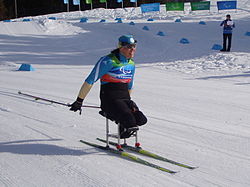Classification of skiers and events
Paralympic cross-country skiing includes standing events, sitting events (for wheelchair users), and events for visually impaired athletes under the rules of the International Paralympic Committee. These are divided into several categories for people who are missing limbs, have amputations, are blind, or have any other physical disability, to continue their sport. The classifications are for: [1]
- Standing skiers with arm impairments, leg impairments or with both arm and leg impairments.
- Sit-Skiers, all with leg impairments, but with varying degrees of torso control.
- Skiers with visual impairment including blindness, low visual acuity, and limited field of vision.
Standing skiers use the two basic techniques in cross-country: classic-style, where the skis move parallel to each other through tracks in the snow, and the free-style or skate skiing where skiers propel themselves in a manner similar to speed skating, pushing off with the edge of their skis on smoothly groomed firm surfaces. Sit-skiers ride on sleds with skis designed for classic style tracks, propelling themselves with poles. Skiers compete in men’s and women’s individual events over short, middle and long distances ranging from 2.5 kilometres to 20 kilometres based on the type of event. Standing skiers compete in events of varying lengths—sprint (ca. 1,200 m), middle (10 km, men and 5 km, women) and long (20 km, men and 15 km, women). Sit-skiers compete in events of shorter lengths—sprint (ca. 800 m), middle (10 km, men and 5 km, women) and long (15 km, men and 12 km, women). [2]
IPC events use one of three available start formats: individual timed starts, pursuit with multiple starters, and relay with successive competitors. Relay races may have competitors with a combination of disabilities, each of whom is assigned a handicap according to a "Nordic Percentage System." The percentage is applied to each skier’s final time and the skier with the lowest calculated time is the winner. [2]
This page is based on this
Wikipedia article Text is available under the
CC BY-SA 4.0 license; additional terms may apply.
Images, videos and audio are available under their respective licenses.

